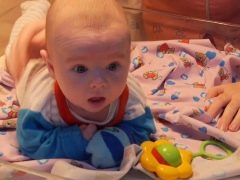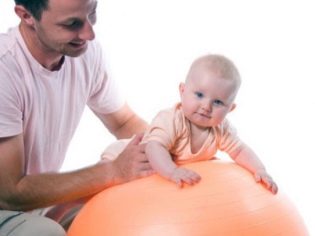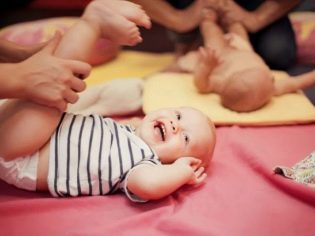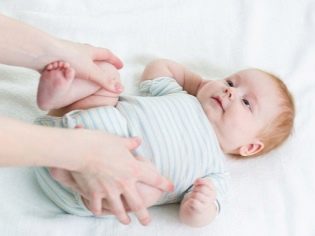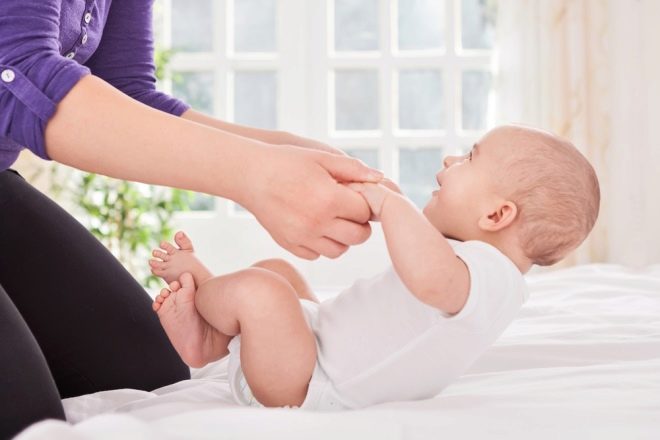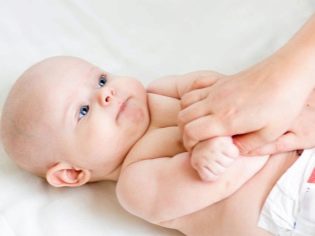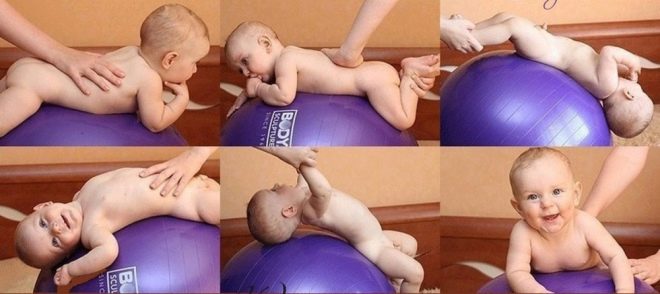Gymnastics for a child 3-4 months
Gymnastics has a positive effect on the well-being and development of a child of any age. But for babies of the first months of life it is especially necessary.
Helping a child learn new skills is the task of any loving parent, because in the overall development of a child of the first year of life, mental, emotional, and physical development are closely interrelated. Without one component, the picture will be incomplete. In this article we will talk about how to conduct gymnastics for children in 3-4 months.
Age features
For a three-month-old baby, the world around us becomes more interesting every day. The baby is already able to hold the head on its stomach, it is already trying to rise on the handles from this position, if something interesting is happening ahead. Scarce emotionally reacts to his mother, smiles, and also more consciously reacts to the touch of adults to different parts of his body. Massage and gymnastics at this age can be a real pleasure and fun game.
At this age, a full color sensation begins to form. That is why bright toys, rattles and perceptible objects will help not only the development of vision, but will also be an excellent stimulus and motivator during children's gymnastics. Sounds can also be used in the same way, because the kid can easily determine where they come from and turns his head with interest.
In 3-4 months, the inborn reflexes start to disappear in the baby, which were actively used by parents during massage and gymnastics from birth. Now they are replaced by conditioned reflexes, the kid is already beginning to try to straighten the body, stretch out. This means that soon the crumb will begin to roll over, and the muscles of the back and legs are preparing for crawling movements.
The baby is asleep during the day is less, wakefulness becomes longer, and this gives additional opportunities for conducting educational activities.
General Charging Requirements
Physical activity for kids should be daily. Therefore, gymnastics should be An integral part of the daily diet. It is necessary to start the exercises after the muscles and ligaments of the baby are “warmed up” by a preliminary massage.
Gymnastics for a four-month-old baby is becoming more complex, now it is not only an effect on the muscles, it is a training of the visual and auditory functions, the formation of the first speech skills - of walking.
Mother can not do without auxiliary materials - you need bright toys, rattles, pleasant music and knowledge of pies, counts, nursery rhymes that develop the perception of the rhythm of human speech.
Every movement should be commented. The baby should gradually master parts of her own body, and mom can help him with this by clearly calling them during the exercise.
At 3 months, the child needs to conduct a comprehensive lesson, all the exercises of which are divided into two groups:
- passive (mother performs the exercise calmly lying child);
- active (the baby takes a lively and direct part in what is happening as far as possible).
Exercises from the physical therapy exercise arsenal are added to the complex for a child with some developmental and health problems, if any are prescribed by the attending physician.
You can add to the exercises exercises on the ball (fitball). Practitioners of dynamic gymnastics complete the exercises by conducting dynamic exercises. Whatever the set of activities for your child, it must include:
- laying on the tummy (develops the muscles of the abdomen and neck);
- workout for limbs (stimulates the muscles of the arms and legs);
- exercises for changing the position of the body in space (turns with support, crawling with support).
Restorative gymnastics does not imply acupressure, massaging and other effects on the spine, lower back (kidney area), on the axillary and popliteal hollows, on the spring on the head.
Gymnastics strengthens the immune system of the child, removes the remains of muscle hypertonia, with which up to 100% of children are born, develops the lungs, normalizes the work of the heart and blood vessels, improves blood circulation. The tone goes away gradually, and this is perfectly normal.
First, the tension in the muscles of the arms weakens, and only by the end of 4 months - the flexor muscles of the legs. But this does not happen to everyone, and some muscle tension is considered quite natural up to six months.
Always conduct a gymnastics on a specific plan, starting with a simple and gradually moving to the complex:
- massage and warm up - 5 minutes;
- passive exercises for arms and legs;
- exercises for joints and ligaments of the limbs;
- general exercises for the development of the muscles of the abdomen and back;
- active exercises (coups, crawling, fitball);
- soothing light relaxation massage - 2-3 minutes.
Impact on the muscles and joints of the child should be careful and insignificant. Otherwise, the kid will hurt the muscles.
Every adult, who at least once overtrained in the gym or played sports games, is painfully familiar with the feeling of "crammed" muscles. In children, muscle tissue behaves in exactly the same way in response to excessive exercise.
So, make sure that the load is moderate, otherwise you will not avoid problems with sleep and appetite.
Exercises
Pre-massage is carried out in the traditional way. At first, they rub and easily massage hands and feet from the fingers upwards. Then, in a circular motion, slightly rub the muscles of the chest and abdomen, back, buttocks. Then you can go directly to gymnastic exercises. We recommend these tricks:
- "Boxer". Lay the baby on the back. Take the brushes of his pens in your own and do them forward attacks, as a boxer usually does in the ring. Exercise well develops the muscles of the arms and upper back, helps strengthen the shoulder joints.
- "Mill". The baby continues to lie on its back. Fix the brushes of his handles between your thumb and forefinger and shake the brushes, and then rotate them in a circle. Do this carefully so as not to injure your baby.
- "Butterfly". Spread the baby's arms to the sides and bring him back to the chest. After you have done this several times, lift the handles up and down them down along the body. Complete the exercises with semicircular motions from top to bottom; the hands of the kid should write out two arcs on either side of him, like butterfly wings.
- "Bicycle". Do not forget about the exercises that you spent on the child in the first weeks after birth. Still remains relevant "Bicycle" - bringing with the bend the legs in the knees alternately. But the usual reception already needs a little complication. When making a "bicycle", lightly press your palms on the feet of the child so that the "pedals" spin with a slight load. Exercise perfectly develops the legs, knee joints, hips, lower and long back muscles.
- "Cuttlefish". Baby is lying on his back. Lift his legs to the head and lower them to their original position. In this case, make sure that the legs do not bend at the knees. To do this, hold the baby's limbs in the ankle area with one hand, and the second - under the knees.
- "Frog". The baby is on the stomach. Place your palms under your feet and push the baby to bend your knees and hip joints. At the same time, his posture will resemble a frog posture. Move the baby forward slightly. This exercise will be a good base for future crawling. Stimulate the participation of the child in the process - put in front of him a bright toy, so that he himself tries to reach it.
- "Turn". Put the child on the back, put your index finger in his right hand so that the baby holds him tightly. Holding the baby by the left side of the body, pull your hand towards yourself and gently make a revolution from the back to the stomach through the left side. Then do a coup through the right side, but for this you need to give the baby grab your finger with the left handle.
- "Caterpillar". Put the child on his stomach, stretch his arms forward, put his hand to the feet and slightly offensively push the baby to move slightly forward. In this case, his handles bent in elbows, again take the handles and put forward. Thus, as a caterpillar, the baby will slowly move forward, for example, to an interesting toy. Remember that the child must have an incentive to perform active exercises. If there is no motivation, there will be no pleasure from gymnastics.
- On the ball. Put the baby belly on the ball, holding the sides. Roll the ball back and forth, left and right. Turn the child on his back and do the same. Exercise stimulates the development of the muscles of the abdomen and back, and also contributes to the development of the vestibular apparatus.
Useful tips
A few helpful tips will help make classes for a three-month-old baby enjoyable:
Turn on the music, talk to the baby - communication will help establish emotional contact, besides the child will perceive gymnastics as a fun and interesting game.
Do not exercise before evening bathing. Exercise stimulates the nervous system and increases blood circulation. As a result, the baby may fall asleep and worry worse at night. It is best to do gymnastics in the morning.
Always watch the mood of the child. If his mood is not very good today, he is naughty, it is better not to do gymnastics.
If the weather and time of year allow, spend gymnastics without clothes and in the fresh air. So it will be possible to combine useful exercise with hardening, as advised by a children's doctor, Yevgeny Komarovsky.
Gymnastics do not do in the days of illness, especially if the child has a fever. Also, you can not do gymnastics without a doctor's participation to children with congenital heart defects, severe renal failure, large hernias (inguinal, umbilical or spinal).
Before you do the exercises, if you start to study with the child for the first time, watch the training video. It will help to understand the technique of execution.
Charging technique for a child 3-4 months, see the following video.
